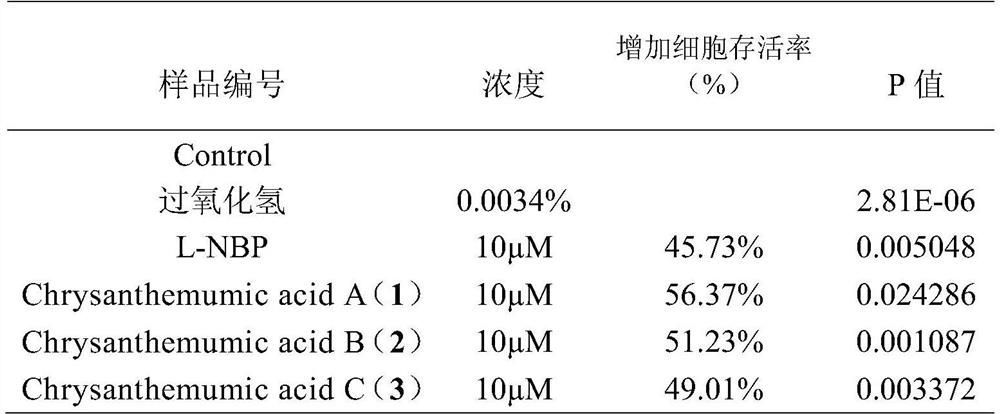A class of compounds extracted from Chrysanthemum chrysanthemum, its pharmaceutical composition and its application in preventing and treating neurodegenerative diseases
A neurodegenerative and compound technology, applied in the field of medicine, can solve the problems such as the patent documents of the preparation method of the monomeric compound of chrysanthemum in the neuron cell, and the traditional Chinese medicine chrysanthemum, so as to prevent and treat neurodegenerative diseases, strengthen the Total Antioxidant Capacity, Structural Novel Effect
- Summary
- Abstract
- Description
- Claims
- Application Information
AI Technical Summary
Problems solved by technology
Method used
Image
Examples
Embodiment
[0023] Example Chrysanthemumic acid A~C (compound 1-3) preparation and identification of Chrysanthemum monomeric compound Chrysanthemumic acid A~C (compound 1-3) 10kg Chrysanthemum medicinal material is extracted 3 times by reflux of 70% ethanol, each time 2 hours, use petroleum ether, chloroform, Ethyl acetate and n-butanol were extracted three times in sequence, the n-butanol part was recovered as solvent, dispersed and dissolved with distilled water, the supernatant was passed through D101 macroporous adsorption resin, eluted with ethanol / water solvent system, and the 70% ethanol eluted part was collected After recovering the solvent, the above compounds Chrysanthemumic acid A (55 mg), Chrysanthemumic acid B (35 mg), and Chrysanthemumic acid C (67 mg) were obtained through repeated purification by gel column chromatography and reverse-phase silica gel column chromatography. After UV, IR, NMR, Its structure was identified by means of spectroscopy such as MS and CD, and it was...
experiment example 1
[0029] Experimental Example 1 Protective effect of Chrysanthemumic acid A~C, Chrysanthemum compound, on SH-SY5Y cells damaged by hydrogen peroxide
[0030] SH-SY5Y cells were cultured in DMEM containing 10% fetal bovine serum (FBS), 100 U / mL penicillin and streptomycin based on 5% CO 2 , cultured in a 37°C incubator. After the cells were 80% confluent, they were subcultured at 1×10 4 cells / mL density, 100 μL per well was inoculated in a 96-well plate overnight. Treat with 10 μM Chrysanthemumic acid A (1), Chrysanthemumic acid B (2), and Chrysanthemumic acid C (3), and replace with 100 μL containing H 2 o2 fresh solution, and continued to incubate for 24 h. Afterwards, 10 μL of MTT (5 mg / mL) was added to each well, and the incubation was continued for 4 h. Discard the medium in the 96-well plate by flipping, add 150 μL of DMSO solution to each well, shake at 37°C for 15 minutes to fully dissolve the crystals, detect the OD value of each well at 570 nm on a microplate reader...
experiment example 2
[0034] Experimental example 2 Chrysanthemumic acid A~C (compound 1-3) monomer compound Chrysanthemumic acid A~C (compound 1-3) scavenging ability of DPPH free radical
[0035] Dispense 10 μL of 2 x 10 -4 Compound M samples were added to a 96-well plate, and then 190 μL of 200 μmol / L DPPH in absolute ethanol was added, reacted at 37° C. in the dark for 30 minutes, and the absorbance was measured at 517 nm. The ability to scavenge free radicals uses Sc (%)=(1-A sample / A control)×100%. The control is the absorbance value of the solution without adding the sample after the reaction.
[0036] As shown in Table 2, compounds Chrysanthemumic acid A~C all have strong scavenging effects on DPPH free radicals, and compound Chrysanthemumic acid A has a stronger ability to scavenge free radicals than the positive control drug Vitamin C.
[0037] Table 2: Results of compounds' ability to scavenge DPPH free radicals
[0038]
PUM
 Login to View More
Login to View More Abstract
Description
Claims
Application Information
 Login to View More
Login to View More - R&D
- Intellectual Property
- Life Sciences
- Materials
- Tech Scout
- Unparalleled Data Quality
- Higher Quality Content
- 60% Fewer Hallucinations
Browse by: Latest US Patents, China's latest patents, Technical Efficacy Thesaurus, Application Domain, Technology Topic, Popular Technical Reports.
© 2025 PatSnap. All rights reserved.Legal|Privacy policy|Modern Slavery Act Transparency Statement|Sitemap|About US| Contact US: help@patsnap.com



